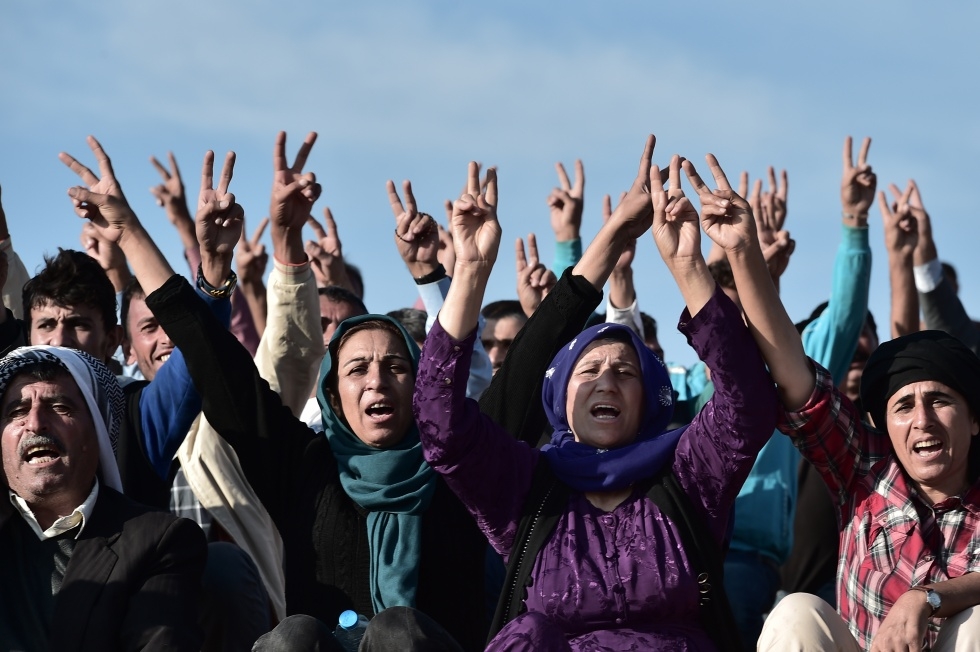Where do Iranian Kurds fit in Iran's Kurdish policy?

Visiting Kurdistan Province in Iran immediately after finalising the nuclear deal with global powers, Iranian President Hassan Rouhani said: “Iran protects Erbil and Baghdad just as it protects Iranian Kurdistan. Without Iran’s help Erbil and Baghdad would be in the hands of terrorist groups right now. Just as we protect Sanandaj we also protect Sulaimani and Duhok.”
Though headline-grabbing, such Kurd-friendly discourse among Iranian high officials has become a common feature of recent times. The Iranian president’s lines were in accordance with what other Iranian high officials have been saying since the Islamic State group (IS) began attacking the Kurdish region of Iraq. These officials have repeatedly indicated that it was Iran who helped save the Kurds and Iraqis from falling into the hands of IS.
Drawing inspiration and insight from these words, a number of analysts and regional experts have propagated the idea of the importance of rapprochement between Iran and Kurds in general and Iran and the Kurdistan Workers' Party (PKK) in particular. One common denominator of the growing literature on the subject heavily invests in the assumption that Turkey is a net loser in this emerging Kurdo-Iranian partnership. Writing in Foreign Affairs, Israeli scholar Michael Tanchum argues:
“A Kurdish-Iranian alignment would provide Tehran with more widespread influence in Iraq and Syria, fundamentally altering the region’s geopolitical chessboard. An Iranian-empowered, PKK-led Kurdish entity spanning Syria and Iraq would also prove a much more intractable problem for Turkey than the current PYD-controlled Rojava. Worse still, with Ankara already having trouble exerting its authority in Turkey’s southeastern Kurdish regions, a PKK-Iranian alignment would turn Tehran into an influential force across a quarter of Turkey’s territory.”
He concluds his alarmist article with even a more ominous conclusion regarding Kurdish relations with Turkey by contending that “Ankara’s offensive against the PKK is an invitation to Iran to bring about a strategic nightmare for Turkey worse than the one Erdogan sought to prevent.”
Reading from a similar script, Mahan Abedin entitled his piece for Middle East Eye "Iran eyes opportunity in Turkey’s new anti-Kurdish drive". In this piece, Abedin attempts to give an account of how Turkey's purportedly anti-Kurdish drive is benefiting Iran and elevating it to the status of saviour of the Kurds in the region. Though he recognises the limitations and continuing suspicion engulfing this new relationship, he is nevertheless sanguine about the strategic and tactical advantages such a partnership might accrue for Iran.
This emerging rosy picture of Iran-Kurdish relations is yet to answer an important question: Where do Iranian Kurds stand in this purported partnership? Most analyses of Iranian-Kurdish relations treat the Kurds as a foreign policy issue for Iran rather than a domestic one, hence Iran’s own Kurds are largely missing in this picture.
Kurdish geopolitics have been highly active in recent years. The Kurds in Syria, Iraq and Turkey have been undergoing a major transformation. The shape and nature of Kurdish politics in these respective countries has changed dramatically in a matter of mere months. In the middle of such a hectic geopolitical environment, Iranian Kurdistan has appeared oddly quiet. In a sense, the Iranian Kurds represent the missing link in the highly volatile contemporary Kurdish politics and geopolitics. This, however, does not mean that nothing major occurs in this part of the Middle East. In fact, a government hanging one Kurdish dissident after another shows that this silence does not represent the normal order of things.
Likewise, in May 2015, the death of a 25-year-old Kurdish woman, Farinaz Khosrawani, who fell from the fourth floor of a hotel in the historical Iranian Kurdish city of Mahabad while allegedly trying to escape sexual assault by an Iranian military officer, triggered waves of protests in the city and across Iranian Kurdistan against the government. Supported by similar protests in Turkey, Syria and Iraqi Kurdistan, these protests soon gained a political and national character. The regime had to deploy forces in other Iranian Kurdish cities – Bukan, Mariwan, Saqez and Sanandaj – to prevent these protests getting out of control. In addition, in July the Iranian PKK affiliate Free Life of Kurdistan (PJAK) claimed that it had conducted deadly attacks on a military outpost in the city of Mariwan. These developments illustrate the simmering tension in Iranian Kurdistan and the fragility of the ceasefire between Iran and the PJAK.
Alongside these developments, the historical experience of the national and political struggle of the Iranian Kurds necessitates a comprehensive response from Iran. Iran has a unique place in the imagination of the Kurdish national movement. The Kurds experienced their first taste of statehood in the modern era with the short-lived Kurdish Republic of Mahabad in 1946. The legendary Molla Moustafa Barzani, the father of Kurdistan Regional Government (KRG) president Mesut Barzani, served as chief of staff in this short-lived experience with the state- and nation-building process. This experience had an important impact on infusing the tribal nature of Kurdish nationalism with the inputs of the middle classes, hence setting the wheel in full motion for the Kurdish movement to transition from being a tribal interest-driven cause to a national one. It was within the framework of the establishment of the Kurdistan Democratic Party of Iran (KDPI) in 1945, the Republic of Mahabad in 1946, and the Kurdistan Democratic Party of Iraq (KDP) in 1946 that educated urban middle-class elements and tribal forces worked together in the service of a national cause, hence more conspicuously stressing the national character of the Kurdish revolts, rebellions and movements over the tribal aspect. Also, as the dates suggest, the foundation of the KDPI precedes the KDP by one year. Moreover, the Kurdish population of Iran is only second to the Kurdish population of Turkey in the region, greater than the Iraqi Kurdish population and far greater than Syrian Kurdish population. Hence, the Iranian regime can only ignore Iranian Kurds’ demands and aspirations at its own peril while devising a purported regional Kurdish policy.
Given the current simmering tension in Iranian Kurdistan and its historical and political legacy, any emerging Kurdish-Iranian partnership should take root first in Iranian Kurdistan and only then can it reach out to the Kurds beyond Iran. As things stand, Iran continues its infamous record of smashing one political dissident after another, a significant chunk of whom are Kurds, leaving Iran’s regional Kurdish policy and ambitions fraught with tensions both on the domestic and regional front. Therefore, the highly pertinent question as to where the Iranian Kurds figure in Iran’s purported regional Kurdish policy remains unanswered. Unless and until this question is answered, Iran’s newly self-adopted role as the saviour of the Kurds in the region will amount to no more than a public relations manoeuvre at best or sheer deception at worst.
-Galip Dalay works as a research director at al-Sharq Forum and senior associate fellow on Turkey and Kurdish Affairs at Al Jazeera Centre for Studies.
The views expressed in this article belong to the author and do not necessarily reflect the editorial policy of Middle East Eye.
Photo: The shape and nature of Kurdish politics in Syria, Iraq and Turkey have changed dramatically in a matter of mere month (AFP)
Middle East Eye propose une couverture et une analyse indépendantes et incomparables du Moyen-Orient, de l’Afrique du Nord et d’autres régions du monde. Pour en savoir plus sur la reprise de ce contenu et les frais qui s’appliquent, veuillez remplir ce formulaire [en anglais]. Pour en savoir plus sur MEE, cliquez ici [en anglais].





